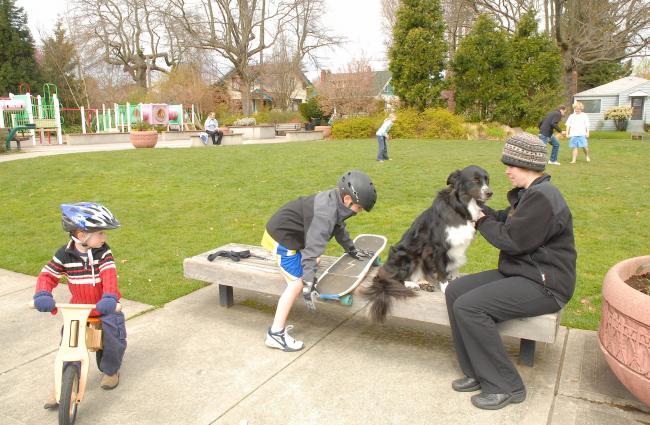Groundswell NW plans for renewed Parks Levy
Webster Park could be one site in Ballard that could benefit from the 2008 Parks Levy Opportunity Fund.
Tue, 03/10/2009
After a continuation of the 2000 Pro Parks Levy was passed last November, Groundswell NW is now creating a plan on how to help the neighborhood implement the six year levy to future parks in Ballard.
At the non-profit's annual meeting March 9, board director Dave Boyd, shared the process of the levy's success while Tim Gallagher, superintendent of Seattle Parks and Recreation was also invited to discuss and answer questions on how the new levy would affect and benefit Ballard in the coming years.
“This was an effort that a couple of our members very early on, almost two years ago, got involved with,” Boyd said. “A citywide group, we called ourselves the Green Legacy Coalition, a coalition of groups that were parks and growth advocates.”
Boyd said the coalition felt it was important to push the levy in part because of cuts in the city budget, so they worked hard to get the Seattle City Council to appoint a Citizen Advisory Committee and put together the parks levy.
“I think it's quite amazing that we got it passed,” Boyd said.
The levy will take in $144, 720,000 starting this year until 2014.
There are a number of projects in Ballard and Crown Hill on the levy list, including the Seventh Elect church site, Webster Elementary, P-patches and possibly funds money for additional acquisitions in the Ballard area through the Opportunity Fund included in the levy.
“There may be park opportunities out there that we don’t know about now but they can come up over the course of this levy,” Boyd said.
The Opportunity Fund goes toward unforeseen park development projects and land acquisition opportunities.
Initially, when the Pro Parks Levy was passed in 2000, the Citizens Oversight committee developed criteria for evaluation and choosing Opportunity Fund projects, based on city council direction in the levy ordinance.
In general, priority was given to projects that addressed a park or open space deficiency, and are in areas experiencing growth, particularly in city-designated “urban villages” or “revitalization areas.”
Ballard Corners Park was partially funded by the Opportunity Fund money. Boyd said.
Gallagher explained that Seattle is more about sustainable landscapes and livable communities and that’s what people want in their community.
“They want facilities they can get to easily, they want to be able to walk to them, they want to have the parks, the open spaces, the trails and the safe routes to school,” Gallagher said. “These are all important in livable communities.”
Changing the levy up a bit from the last go around, Gallagher said they are doing a number of different things.
The city plans to have a number of community meetings to make residents feel some ownership of the levy, discuss its parameters, how they think it should work, what projects are funded in particular areas, the scope of work, timelines for projects and how the Opportunity Fund could be allocated.
“We’re trying to get in front of the ball game with the public instead of waiting to be reactive,” said Gallagher. “We’re in the process right now of setting up the Citizen Oversight Committee, which is important so we can fast track this levy as quickly as possible.”
Eight members from the previous committee have agreed to continue on. The mayor and council will reappoint them while they will also be looking for another eight members ti complete the committee.
“The reason why we want to fast track that, get them on board and get them functioning by next week is so we can start laying out projects and move forward and get projects underway as quickly as possible,” Gallagher said.
The mayor has agreed to bond up front up to $40 to 60 million of the levy so projects can get started immediately.
“Instead of waiting for tax dollars to come in, if you annualize it, it will be about $20 to $25 million a year,” he said. “If we paid as we went many of these projects wouldn't’ happen until years four, five and six.”
By buying up front they are able to have their “own little economic stimulus program," Gallagher said.
“There’s a number of different thing we are looking at to move these projects out in a quick fashion,” he said. “ Our planning and development staff are starting to do some design work in advance of funds coming in.”
Also in consideration for purchase with Parks Levy funds are Webster and Crown Hill Elementary school properties.
The Webster playground area is being purchased from the school district and a formal escrow agreement is nearly done, said Andrea Faste, president of Groundswell NW.
However, Crown Hill Elementary is taking a little longer and the actual purchase and sales agreements are still a ways out, she said.
Deemed surplus school sites by the Seattle School District who will not be reusing them and instead have decided to sell the buildings, the city has been in negotiations to buy the adjacent land from these buildings.
The Webster Elementary building is being leased by the Nordic Heritage Museum while Small Faces Child Development Center bought the Crown Hill Elementary building last fall.
Seattle Parks and Recreation will be turning the land into park sites once sales are final.


